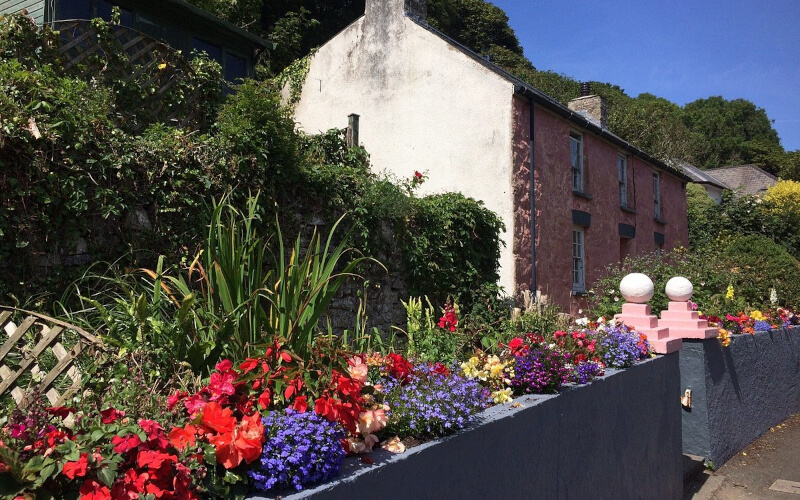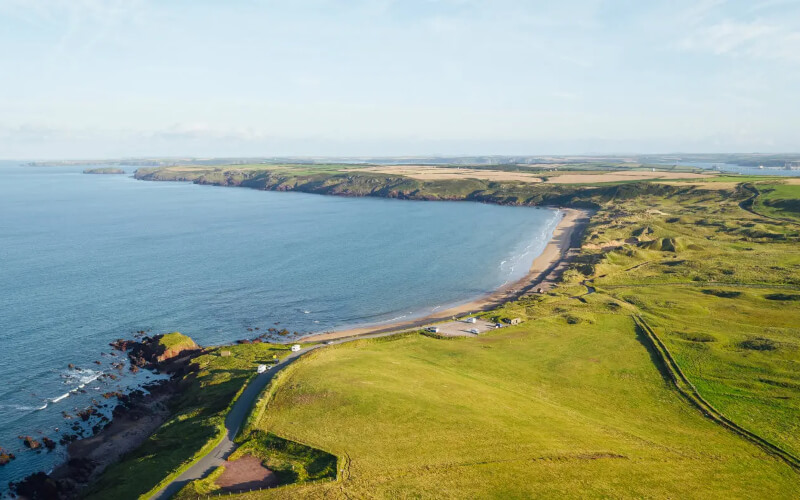How seaweed farmers on Wales’ west coast are regenerating both the ocean and the economy with the local supercrop.
“Welcome to the wonderful world of seaweed,” says Jo Haines as she tramps across an autumnal field on the outskirts of St Davids, in the far west of Wales. She stops outside a polytunnel — a plastic, greenhouse-like structure — and slides open the door. “It’s not very glamorous,” she says. “But this is what being a seaweed farmer is all about.” Inside, lines of rope are festooned with a forest of drying seaweeds: flat, frilly, ribbon-like or rubbery, with colors ranging from vermilions and crimsons to ochres and maroons. The tunnel is a living, and pungent, seaweed pantry.
“There are hundreds of seaweeds around Britain, many of which are edible,” Jo says. “In here, we have sugar kelp, sea lettuce, dulse and sea spaghetti. Most we’ll use ourselves or send to restaurants; our seaweed is served by some of the U.K.’s top Michelin-starred chefs.” She hands me some sugar kelp to taste. It’s salty and mineral-forward, like spinach laced with a sea tang. It’s good in salads, Jo says, or for making sushi or pasta, and it’s also a superb accompaniment for seafood.
But the work Jo and her team do at Câr-y-Môr — Wales’ first community-owned regenerative ocean farm — is about more than exploring seaweed’s culinary uses. Operating on a ramshackle farm alongside the craggy, gorse-cloaked cliffs of Pembrokeshire Coast National Park, Câr-y-Môr is one of a new generation of businesses seeking to harness seaweed’s sustainable potential.
Set up in 2020 by Jo’s dad, Owen Haines, an exoyster and mussel farmer, Câr-y-Môr was inspired by pioneering projects such as GreenWave, the U.S.based foundation that is training a swell of regenerative ocean farmers. It’s a concept that’s well-suited to West Wales, an area with a long fishing history whose coastal communities have been decimated by the double whammy of falling fish stocks and degraded marine ecosystems. Seaweed has been harvested here for centuries. Now, the Câr-y-Môr team, and other seaweed enthusiasts on Wales’ west coast, believe it can play an important role in regenerating the ocean environment, combating climate change and kickstarting the local economy.
There are many reasons to be excited about seaweed. For starters, it’s a superfood packed with polyphenols, carotenoids, omega-3 fatty acids, polysaccharides, amino acids and a cocktail of vitamins and minerals. Some nutritionists believe regular seaweed consumption may help explain why Asian nations, such as Japan and Korea, have lower rates of cancer and cardiovascular disease.
Seaweed can also be transformed into a surprising range of products. In addition to salad sprinkles, beer and bathstuffs, Câr-y-Môr is experimenting with making bioplastics, biofuels and, most notably, fertilizers. Gardeners have long known about seaweed’s growth-boosting benefits, and Câr-y-Môr hopes its innovative biostimulant will provide an environmentally friendly alternative to the industrially produced, chemical-heavy fertilizers responsible for so much of the world’s water pollution.
Thirty miles down the coast, Jonathan Williams is also championing seaweed’s superpowers. The chef, entrepreneur and seaweed fanatic is the proprietor of the Pembrokeshire Beach Food Company, which offers everything from seaweed-based condiments and spice rubs to spirits and tea. He tends his own seaweed garden in the waters of Milford Haven, and is the founder of National Laverbread Day, an annual celebration of Wales’ most famous seaweed-based dish: laverbread (bara lawr in Welsh), the gooey paste that’s an essential part of a traditional Welsh breakfast.
Jonathan also runs Cafe Môr, a solar-powered mobile kitchen inside a repurposed fishing boat. Cafe Môr recently moved to the Old Point House, a historic seaside pub near Angle that Jonathan has run since 2021. Seaweed is, unsurprisingly, the star of Cafe Môr’s menu, from the beef burger laced with laverbread and served with seaweed chili sauce to Jonathan’s bestseller, a breakfast roll featuring fried egg, bacon, Welsh cheddar cheese, laverbread patty and a dusting of a salt and seaweed blend called Mermaid Confetti.
“Seaweed is the most amazing stuff,” Jonathan says as he hauls a rope up from one of the buoys in his garden. The rope is entangled with different seaweeds, along with a menagerie of mussels, oysters and crustaceans. Seaweed provides a vital marine habitat, he says, but it’s also a natural ocean filter and form of carbon capture. “I honestly believe seaweed can change the world, if we give it a chance.”
Despite his enthusiasm, ocean farming, for now, remains a niche pursuit in the U.K., and Jo and Jonathan acknowledge it will take time to spread the word about its potential. Câr-y-Môr currently has three live sites: Together they span more than seven acres, but the goal is to farm at least 25, pending permission from the environmental regulator, Natural Resources Wales, and other organizations. It’s hard to imagine there will be many objections: Non-polluting and requiring little visible infrastructure, Câr-y-Môr’s seaweed farming operation is about as green as agriculture gets.
“One of the loveliest things about becoming seaweed farmers has been the community,” Jo says. “We’ve been so inspired by the support we’ve received from other ocean farms around the world, from the Netherlands to Japan to California. Ultimately, we’re all working towards the same goal: unlocking seaweed’s secrets.”






